| With the technology community a-twitter over stories of patent trolls ravaging the start-up landscape, runaway mobile patent wars, and blooming secondary IP markets, many early-stage entrepreneurs find themselves considering whether or not to seek patents around their technologies. But what are the real benefits of patents, and what kinds of things are even eligible for such protection? The answer to both questions is: More than you might think. |
What is patentable?
We tend to think of patentable inventions as revolutionary and complex, new technologies. However, nothing in the law requires such a standard. Generally, to be eligible for a US patent, the invention just has to be:
We tend to think of patentable inventions as revolutionary and complex, new technologies. However, nothing in the law requires such a standard. Generally, to be eligible for a US patent, the invention just has to be:
- Novel — not known or used by others in the US or previously published anywhere in the world.
- Non-obvious — the invention could not have been obvious “to one of ordinary skill in the art”. So, for example, if a new mechanism for relating information from various social networking websites is not an obvious invention to a phone handset hardware engineer, although is an obvious next step to any software engineer, that invention is unlikely to become a valid patent.
- Useful — the invention has to perform its intended use.
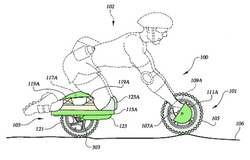
Additionally, the invention must be of "patentable subject matter". Processes, machines, manufactures, or compositions of matter, or improvements to any of these all fall under the realm of patentable subject matter. Note that if even your invention is just a new use of an already known process, you may be able to get a process patent, provided that all of the other requirements of a patent are met, including in particular “non-obviousness” listed above. Ornamental designs of useful products are also acceptable subject matter, and an be protected by “design patents”.
However, you cannot patent a “law of nature” such as photosynthesis, although if you used photosynthesis to develop a new fuel or drug, your invention may be eligible for a patent. Business methods are also patentable subject matter, although in 2010 the US Supreme Court threw into question the review standards for business method patents.
Finally, to be patentable an invention must meet what is called the "enabling requirement". The enabling requirement provides that your patent application must include a written description of the invention, and of the process of making and using it. Ultimately, any reasonably skilled person in your field should be able to read your patent and re-create your invention. This generally means that you cannot patent a mere idea.
However, you cannot patent a “law of nature” such as photosynthesis, although if you used photosynthesis to develop a new fuel or drug, your invention may be eligible for a patent. Business methods are also patentable subject matter, although in 2010 the US Supreme Court threw into question the review standards for business method patents.
Finally, to be patentable an invention must meet what is called the "enabling requirement". The enabling requirement provides that your patent application must include a written description of the invention, and of the process of making and using it. Ultimately, any reasonably skilled person in your field should be able to read your patent and re-create your invention. This generally means that you cannot patent a mere idea.
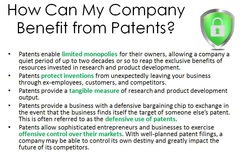
Click to View
Patents and You
Even a young technology company without an army of engineers likely has some developments that can be patented, and since a patent is a government granted monopoly that allows only you (or your company) to make, use and sell your invention for a limited period of time, you can build powerful barriers to entry for your competition.
In the U.S., a patent holder’s exclusive rights last for 20 years from the date the patent application is filed (although drugs, medical devices and additives may receive up to 5 year extensions, and design patents are protected for only 14 years from the date of filing.)
Even a young technology company without an army of engineers likely has some developments that can be patented, and since a patent is a government granted monopoly that allows only you (or your company) to make, use and sell your invention for a limited period of time, you can build powerful barriers to entry for your competition.
In the U.S., a patent holder’s exclusive rights last for 20 years from the date the patent application is filed (although drugs, medical devices and additives may receive up to 5 year extensions, and design patents are protected for only 14 years from the date of filing.)
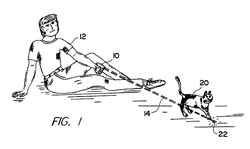
Method of exercising a cat
If They Can Do It....
So Can You. To emphasize the point that a patentable invention doesn’t need to include break-through technology, here are some actual examples of inventions that were awarded patents in the US:
So Can You. To emphasize the point that a patentable invention doesn’t need to include break-through technology, here are some actual examples of inventions that were awarded patents in the US:
- US5255452: Method and means for creating anti-gravity illusion – Michael Jackson shoe allowing wearer to lean beyond normal center of gravity.
- US5443036: Method of exercising a cat – The method involves using a laser pointer.
- US5457821: Hat simulating a fried egg – A hat which looks like a fried or sunny-side egg.
- US6637447: Beerbrella – a small, removable umbrella which can be attached to a beverage container to provide shade.
- US5878931: Halloween backpack – has a chute for easy insertion of candy but not removal and leaves the child’s hands free to continue carrying a flashlight.
- US6711769: Pillow with Retractable umbrella – essentially a pillow with an adjustable umbrella to shield a user’s face from the sun.
- US6739074: Tamper resistant institutional shoe and method – a shoe with a tamper-resistant, transparent sole to prevent concealment of contraband for use in prisons or correctional facilities.
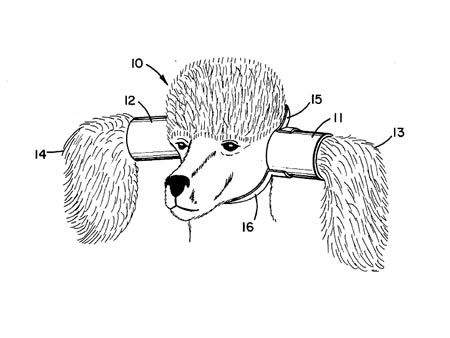
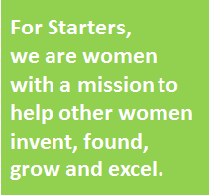
 RSS Feed
RSS Feed
